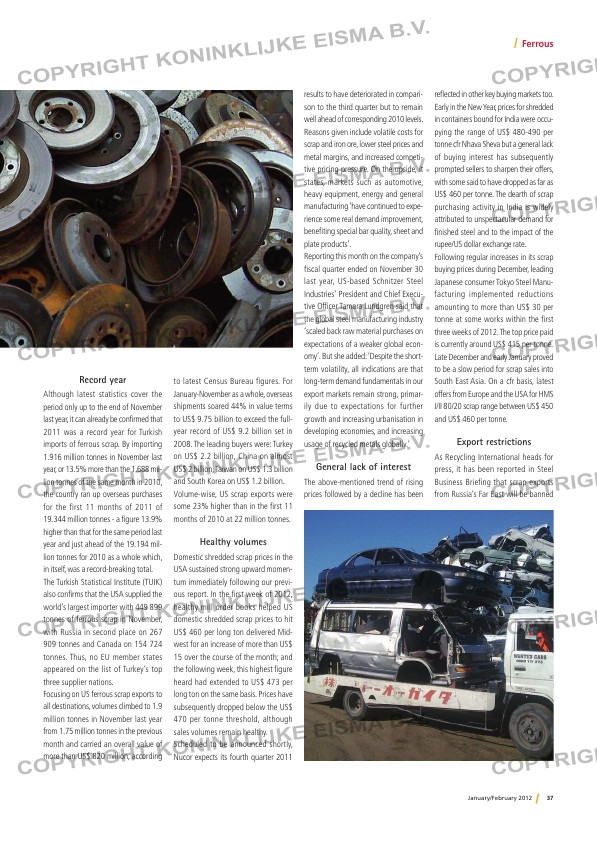Page 37 from: January / February 2012

37January/February 2012
Ferrous
Record year
Although latest statistics cover the
period only up to the end of November
last year, it can already be confirmed that
2011 was a record year for Turkish
imports of ferrous scrap. By importing
1.916 million tonnes in November last
year, or 13.5% more than the 1.688 mil-
lion tonnes of the same month in 2010,
the country ran up overseas purchases
for the first 11 months of 2011 of
19.344 million tonnes – a figure 13.9%
higher than that for the same period last
year and just ahead of the 19.194 mil-
lion tonnes for 2010 as a whole which,
in itself, was a record-breaking total.
The Turkish Statistical Institute (TUIK)
also confirms that the USA supplied the
world’s largest importer with 449 899
tonnes of ferrous scrap in November,
with Russia in second place on 267
909 tonnes and Canada on 154 724
tonnes. Thus, no EU member states
appeared on the list of Turkey’s top
three supplier nations.
Focusing on US ferrous scrap exports to
all destinations, volumes climbed to 1.9
million tonnes in November last year
from 1.75 million tonnes in the previous
month and carried an overall value of
more than US$ 820 million, according
to latest Census Bureau figures. For
January-November as a whole, overseas
shipments soared 44% in value terms
to US$ 9.75 billion to exceed the full-
year record of US$ 9.2 billion set in
2008. The leading buyers were: Turkey
on US$ 2.2 billion, China on almost
US$ 2 billion, Taiwan on US$ 1.3 billion
and South Korea on US$ 1.2 billion.
Volume-wise, US scrap exports were
some 23% higher than in the first 11
months of 2010 at 22 million tonnes.
Healthy volumes
Domestic shredded scrap prices in the
USA sustained strong upward momen-
tum immediately following our previ-
ous report. In the first week of 2012,
healthy mill order books helped US
domestic shredded scrap prices to hit
US$ 460 per long ton delivered Mid-
west for an increase of more than US$
15 over the course of the month; and
the following week, this highest figure
heard had extended to US$ 473 per
long ton on the same basis. Prices have
subsequently dropped below the US$
470 per tonne threshold, although
sales volumes remain healthy.
Scheduled to be announced shortly,
Nucor expects its fourth quarter 2011
results to have deteriorated in compari-
son to the third quarter but to remain
well ahead of corresponding 2010 levels.
Reasons given include volatile costs for
scrap and iron ore, lower steel prices and
metal margins, and increased competi-
tive pricing pressure. On the upside, it
states, markets such as automotive,
heavy equipment, energy and general
manufacturing ‘have continued to expe-
rience some real demand improvement,
benefiting special bar quality, sheet and
plate products’.
Reporting this month on the company’s
fiscal quarter ended on November 30
last year, US-based Schnitzer Steel
Industries’ President and Chief Execu-
tive Officer Tamara Lundgren said that
the global steel manufacturing industry
‘scaled back raw material purchases on
expectations of a weaker global econ-
omy’. But she added: ‘Despite the short-
term volatility, all indications are that
long-term demand fundamentals in our
export markets remain strong, primar-
ily due to expectations for further
growth and increasing urbanisation in
developing economies, and increasing
usage of recycled metals globally.’
General lack of interest
The above-mentioned trend of rising
prices followed by a decline has been
reflected in other key buying markets too.
Early in the New Year, prices for shredded
in containers bound for India were occu-
pying the range of US$ 480-490 per
tonne cfr Nhava Sheva but a general lack
of buying interest has subsequently
prompted sellers to sharpen their offers,
with some said to have dropped as far as
US$ 460 per tonne. The dearth of scrap
purchasing activity in India is widely
attributed to unspectacular demand for
finished steel and to the impact of the
rupee/US dollar exchange rate.
Following regular increases in its scrap
buying prices during December, leading
Japanese consumer Tokyo Steel Manu-
facturing implemented reductions
amounting to more than US$ 30 per
tonne at some works within the first
three weeks of 2012. The top price paid
is currently around US$ 415 per tonne.
Late December and early January proved
to be a slow period for scrap sales into
South East Asia. On a cfr basis, latest
offers from Europe and the USA for HMS
I/II 80/20 scrap range between US$ 450
and US$ 460 per tonne.
Export restrictions
As Recycling International heads for
press, it has been reported in Steel
Business Briefing that scrap exports
from Russia’s Far East will be banned
p3 _ erro .indd 3 2 -01-12 1 :0



